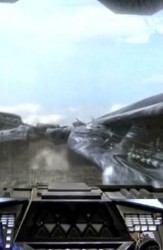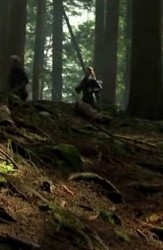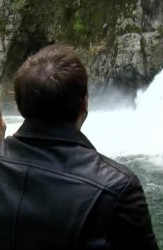“The Shrine†is one of the most emotionally powerful episodes of Stargate Atlantis to date, as viewers witness McKay’s tragic mental demise. Written by Stargate SG-1 and Stargate Atlantis co-creator Brad Wright, the episode heralds the former show-runner’s welcome return to scripting the show.
Director Andy Mikita laughingly admits that the prospect of directing Wright’s return to the writing roster was somewhat daunting. Though the pair has worked together for years, there’s just something about directing a script written by one of the show’s creators.
 “I have to confess I didn’t go into it quite as relaxed and comfortable as I usually would,†he chuckles. “I felt a little bit of extra pressure. And I don’t know why. It’s silly, because Brad is such a relaxed, collaborative fellow and his scripts are absolutely wonderful. This one, of course, drew an awful lot of attention because it was such a great script and there is so much for all the actors, especially David Hewlett.â€
“I have to confess I didn’t go into it quite as relaxed and comfortable as I usually would,†he chuckles. “I felt a little bit of extra pressure. And I don’t know why. It’s silly, because Brad is such a relaxed, collaborative fellow and his scripts are absolutely wonderful. This one, of course, drew an awful lot of attention because it was such a great script and there is so much for all the actors, especially David Hewlett.â€
In the event, Mikita and Wright spent a substantial amount of time discussing the episode before production even began.
“We spoke at length about the show even before he had released the script, he had given me an indication of what the story was and what some of the components were going to be,†explains the director. “We prepped very closely together, which for me was wonderful, primarily because he wrote the script and had some very clear ideas as to what he would like to see and how that could be articulated.â€
It was immediately clear that the success of the episode would hinge on how McKay’s degeneration would occur. This obviously put a lot of expectation on David Hewlett, and Mikita, along with Wright, spent a lot of time determining how to approach the key ‘video log’ scenes.
“The biggest thing was the tracking of McKay and the degree of illness that he was suffering from throughout the episode from the video logs that we were doing,†Mikita explains. “We talked to David Hewlett in advance, all three of us sat down in his trailer and discussed it quite extensively, and came to an agreement in terms of the tone of his performance and the different levels that he had to get to.â€
 Because of the emotional nature of these scenes, it was decided that extra time was needed to prepare before filming. A television schedule doesn’t always allow for long rehearsals, but this time one was deemed necessary. In the end, though, the rehearsal day turned into something more.
Because of the emotional nature of these scenes, it was decided that extra time was needed to prepare before filming. A television schedule doesn’t always allow for long rehearsals, but this time one was deemed necessary. In the end, though, the rehearsal day turned into something more.
“We ended up shooting it in prep – we were going to have a rehearsal day with David, and it turned out we had time to actually shoot it,†says Mikita. “So everything that turned up on the show for the video logs, we were able to film very quickly one afternoon and what started out as a rehearsal day actually ended up being the material that we used in the show. It helped everyone to get that done ahead of time, because it just gave everybody a good sense of the tracking of his illness. And it took a curse off the shooting schedule, because after we had it in the can it didn’t fall into our regular schedule, so that was terrific.â€
Going into the day as just a rehearsal also helped get the balance right for each of the difficult scenes. Mikita and Hewlett, with Wright also in attendance, could discuss just what degree of disability was required during the progression of McKay’s illness.
“We shot those with Brad there, sitting right behind the camera. We just had a very small crew – we did it really guerrilla style, and collectively we were able to decide what was too much and what was too little. When we shot it we did it basically in continuity. So we started with him as himself and took baby steps to get him where it needed to go. We played with it a little bit, and were afforded the time to do that because we set up our own little mini unit – there was nothing else going on that day so we had the whole afternoon to play with. But it just proved that David was really on track with it right off the bat. And then Brad’s presence there was great in terms of confidence levels, and making sure we were all on the same page.â€
It wasn’t only David Hewlett that had some heavy emotional scenes to contend with. Kate Hewlett returns to Atlantis as McKay’s sister, Jeannie, forced to bid her once-genius brother a painful goodbye. These scenes were very different to episodes that she had filmed for the series before – there was certainly no humour to be had from her brother’s mental demise.
“It all presented itself quite naturally,†Mikita recalls of the scene in which Jeannie first talks to her brother. “In fact, the sequence where Jeannie went to visit the hospital room where McKay is being held was quite something. When we did our very first blocking rehearsal, she burst into tears at exactly the appropriate point, which was wonderful ¬– but I think she had a tough time getting back to that level. It was very emotional for her, especially because they’re real life brother and sister as well. But we kept things pretty intimate, and they’re both such wonderful actors that it didn’t really require much on my part,†he observes, with a self-deprecating laugh. “I was sitting back and watching it happen for the most part, and I can’t take very much credit at all for that.â€
 The emotion of the episode was not the only challenging aspect of the story from Mikita’s point of view. The script also called for the Stargate – and the lead cast – to be submerged in water. Since dipping the entire gate in a pool deep enough to cover it almost completely would be too costly an exercise, Mikita and his director of photography, Jim Menard, had to come up with an alternative way to make the scene work.
The emotion of the episode was not the only challenging aspect of the story from Mikita’s point of view. The script also called for the Stargate – and the lead cast – to be submerged in water. Since dipping the entire gate in a pool deep enough to cover it almost completely would be too costly an exercise, Mikita and his director of photography, Jim Menard, had to come up with an alternative way to make the scene work.
“A lot of time was spent in pre-production with that one,†the director admits. “There were some financial restrictions placed upon us, and there was only so much we could do. So we had our one big hero visual effects shot, which was the end of that scene. Then we actually built a section of the Stargate in the studio, and used fish tanks to submerge the cameras and put some atmosphere in the air with rear-screen projections. We had some wind blowing and the actors were soaking wet – we had to wet them all down, which was great fun,†he chuckles, “we all took great pleasure in doing that over and over again! But yeah, that was a tricky one, we had to test that pretty extensively in pre production to make sure it was going to work, doing so many practical elements instead of it all being visual effects. Another sequence that’s worthy of note,†Mikita adds, “is the Sheppard-McKay scene with the two of them sitting on the end of the pier. It was a great scene and all the backgrounds were done with visual effects, we didn’t do any of them practically. But it’s just a great scene, both Joe and David are really just tremendous. I think it’s one of my, if not the favourite scene, of the episode.â€
Overall, Mikita feels that “The Shrine†is, from his perspective, a resounding success, and hopes that viewers will feel the same.
“It’s an episode that I have a feeling will be met with some mixed reviews,†the director muses. “I have a feeling that some people may love it and for some people it may not be their cup of tea. It’s not a huge action episode as we’re used to seeing– it’s much more of a performance piece. But it’s really quite something. It’s a wonderful script, and some of the performances are amongst the best we’ve had on the show. So hopefully people will enjoy it.â€
News article courtesy of the official Stargate Website